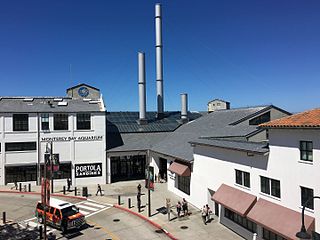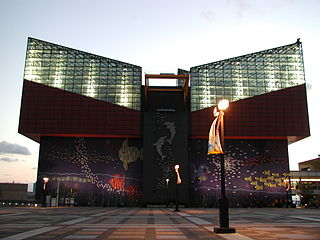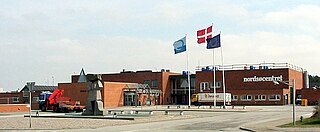
Monterey Bay Aquarium is a nonprofit public aquarium in Monterey, California. Known for its regional focus on the marine habitats of Monterey Bay, it was the first to exhibit a living kelp forest when it opened in October 1984. Its biologists have pioneered the animal husbandry of jellyfish and it was the first to successfully care for and display a great white shark. The organization's research and conservation efforts also focus on sea otters, various birds, and tunas. Seafood Watch, a sustainable seafood advisory list published by the aquarium beginning in 1999, has influenced the discussion surrounding sustainable seafood. The aquarium was home to Rosa, the oldest living sea otter at the time of her death, and it is the birthplace of Otter 841.

The International Exhibition of 1862, officially the London International Exhibition of Industry and Art, also known as the Great London Exposition, was a world's fair held from 1 May to 1 November 1862 in South Kensington, London, England. The site now houses museums including the Natural History Museum and the Science Museum.

The Osaka Aquarium Kaiyukan is an aquarium located in the ward of Minato in Osaka, Osaka Prefecture, Japan, near Osaka Bay. When it first opened, it was the largest public aquarium in the world.

Expo '75 was a World's Fair held on the island of Okinawa in Japan from July 20, 1975, to January 18, 1976.

The Colonial and Indian Exhibition of 1886 was held in South Kensington in London with the objective to "stimulate commerce and strengthen the bonds of union now existing in every portion of her Majesty's Empire". The exhibition was opened by Queen Victoria, and when it closed had received 5.5 million visitors.
The New Zealand and South Seas International Exhibition was a world's fair held in Dunedin, New Zealand from 17 November 1925 until 1 May 1926, which celebrated that country and the South Seas. It was the third such exhibition held in Dunedin, with earlier exhibitions in 1865 and 1889. The exhibition had over 3 million visitors. It had added a new 'Special Exhibits' section focusing on art and craftwork made by women, a breakthrough that lifted the profile of women's art and craftwork.

Birch Aquarium is a public aquarium in La Jolla, California. It serves as the public outreach center for the Scripps Institution of Oceanography at the University of California, San Diego. The aquarium houses more than 3,000 animals representing over 380 species. It has an annual attendance of more than 439,000. The hilltop site provides views of La Jolla Shores and the Pacific Ocean. The aquarium is an accredited member of the Association of Zoos and Aquariums (AZA).

The Suncor Energy Fluvarium, or simply The Fluvarium, is a public centre for environmental education, located in St. John's, Newfoundland and Labrador, and operated by the Quidi Vidi/Rennie's River Development Foundation.

Taraporewala Aquarium or Taraporevala Aquarium is India's oldest aquarium and one of Mumbai's main attractions. It hosts marine and freshwater fish. The aquarium is located on Marine Drive.

Nordsøen Oceanarium is a public aquarium and museum that opened in 1998 on the shores of the North Sea in Hirtshals, north Jutland, Denmark. Their main tank, which holds 4,500,000 litres (1,200,000 US gal), is the largest in Northern Europe, but the Oceanarium also has several smaller habitat aquariums and an exhibit with seals. Species displayed are native to the oceans around Denmark.

Aquarama Aquarium Theater of the Sea, also known as Aquarama, was a unique 1960s aquarium attraction located in South Philadelphia, Pennsylvania, at the intersection of Broad Street and Hartranft Street, just west of the South Philadelphia Sports Complex, south of Marconi Plaza, north of FDR Park, Philadelphia Naval Shipyard and Philadelphia Naval Hospital. It adjoined the east border of the newly developed residential neighborhood Packer Park at 3300 South Broad Street.
The Clifton Fish Aquarium was an aquarium located in Clifton, Karachi, Pakistan, near to Abdullah Shah Ghazi's shrine. It was in operation from 1965 to 1998. It was Karachi's largest public aquarium.

The Marine Biological Association of the United Kingdom (MBA) is a learned society with a scientific laboratory that undertakes research in marine biology. The organisation was founded in 1884 and has been based in Plymouth since the Citadel Hill Laboratory was opened on 30 June 1888.
Van Kleef Aquarium was an oceanarium located along River Valley Road, at the foot of Fort Canning Hill, in Singapore. Fully air-conditioned, the aquarium had 6,500 animals at the time of opening, which were housed in freshwater, seawater, and swamp tanks respectively.

The International Inventions Exhibition was a world's fair held in South Kensington in 1885. As with the earlier exhibitions in a series of fairs in South Kensington following the Great Exhibition, Queen Victoria was patron and her son Albert Edward, the Prince of Wales, was president of the organising committee. It opened on 4 May and three and three-quarters of a million people had visited when it closed 6 months later.
John Dixon Gibbs (1834–1912) was a British engineer and financier who, together with Lucien Gaulard, is often credited as the co-inventor of the AC step-down transformer. The transformer was first demonstrated in 1883 at London's Royal Aquarium. At the time the term "transformer" had not yet been invented, so instead it was referred to as a "secondary generator". Although he is usually credited equally with Gaulard, Gibb's role in the invention appears to have been more that of a financial backer and businessman.

The Stanley Cycle Show or Stanley Show was an exhibition of bicycles and tricycles first mounted by the Stanley Cycling Club in 1878 at The Athenaeum in London's Camden Road. Britain's first series production cars were displayed at this show in November 1896. The 34th and last exhibition was held in the Royal Agricultural Hall, Islington in November 1910. It was supplanted by the 1911 Olympia Motor Cycle Show and, a few weeks before that, Olympia's International Motor Exhibition.

The Woods Hole Science Aquarium (WHSA) is a small public aquarium in Woods Hole, Massachusetts, United States. It is owned by the US government and operated by the National Marine Fisheries Service and the Marine Biological Laboratory.

Frank Cundall was an English art historian, editor and author, the son of the writer and publisher Joseph Cundall. He was closely involved in the administration of and produced the reports for a series of international exhibitions held in London in the 1880s, and catalogued the art library at the South Kensington Museum, later the Victoria and Albert Museum.

The International Health Exhibition was one of a series of international exhibitions held in South Kensington, London, in the 1880s under the patronage of Queen Victoria and the Prince of Wales. Four million people visited the 1884 exhibition. The exhibition's motto was "From labour health, from health contentment springs".
















